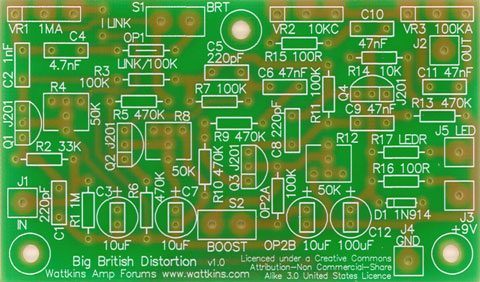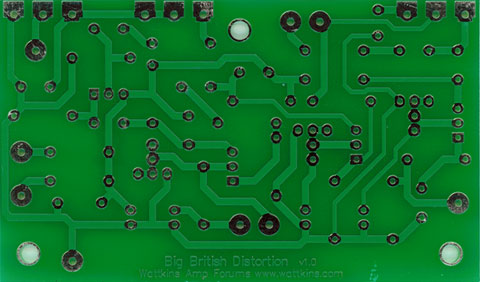Big British Distortion PCB
- Login to post comments
Updated: August 4th 2011
 This circuit is a high-gain circuit modeled after the classic British distortion sound. It's not another "clone" pedal. Special thanks to Burchtone for the original schematic (see below), and Katopan for the PCB layout.
This circuit is a high-gain circuit modeled after the classic British distortion sound. It's not another "clone" pedal. Special thanks to Burchtone for the original schematic (see below), and Katopan for the PCB layout.
Current Status:
We have received our first batch of PCBs and these are now shipping.


 Obtaining the PCB:
Obtaining the PCB:
You can order the official BBD PCB here:
http://www.tubeface.com/wattkins/bbd
Schematic:
http://www.wattkins.com/files/wattkins/burchtone%20british%20distortion.pdf
Main Discussion:
http://www.wattkins.com/node/16888
Parts List:
http://www.wattkins.com/files/wattkins/BBD%20PCB%20Parts%20List.txt (text)
http://www.wattkins.com/files/wattkins/BBD%20PCB%20Parts%20List.xls (Excel)
PCB Assembly Notes:
- Don't forget to install the link wire next to gain pot VR1! The gain pot will be ineffective without the link wire.
- OP1 LINK/100K is option 1 included on the PCB (more info below under Component Choices). It needs to have either a link wire or a resistor installed for the bright switch to be effective.
- Pot orientation on the PCB is made for the pots to be PCB mounted or wired off-board and located above the board with the pot legs at the bottom pointing toward the board. If the pots are mounted with the legs at the top, or if the PCB is installed upsidedown (components same side as pot shafts) then the outer wires to the PCB will need to be swapped over.
- PCB mounted pots will support the board once installed in an enclosure if soldered as shown on the RFD FAQ page.
Component Choices:
- All JFets are J201. 2N5457 may be used for less maximum gain, but brighter top end.
- R4, R8 and R12 are trim pots. 50k is recommended, but depending on JFet variation, 25k, 50k or 100k may be used. Approximate setting for the average J201 is ~22k.
- If the sound is too dark for your amp/speakers, reduce or remove C5 and C8. Further brightness may be added by reducing the value of C11.
- If reduced top end gain is desired when Bright is engaged, add a resistor between C4 and Bright Switch. 100k is recommended but adjust value to taste.
- Ceramic caps are recommended for all pF values, box film caps for all nF values, and aluminum electrolytics for all uF values.
- An additional gain boost may be added by bypassing R12 with a 10uF cap as done on R4 and R8. Be aware C6 and possibly C9 may need reduced to approximately 1n to reduce mushy response. The gain boost may be made switchable. Add 100k between the gain boost cap and the source of Q3. To switch, simply short the 100k with the switch for more gain. Using this method will produce no pops when switched.
- Keep leads short, as there is chance for oscillation. Shielded wire is a good idea, but not required.
* This is OP1 (option 1) on the PCB. OP1 needs to be either a link wire or the mentioned resistor. As mentioned above the bright switch will be ineffective without either a link wire or resistor here.
* This is OP2A & OP2B (option 2) on the PCB. OP2A is the 100k pop removing resistor. OP2B is the 10uF source resistor bypass cap. If you don't want the gain boost option leave nothing connected to the pads of OP2A|100K, OP2B|10uF & S2|BOOST. Boost engaged all the time install OP2A & OP2B, and a jumper wire for S2. Switchable install OP2A, OP2B and S2.
Drill Plans & Labels:
Coming Soon!
Errata:
None yet!

wattkins.com BBD PCB by Wattkins Amp Forums is licensed under a Creative Commons Attribution-Noncommercial-Share Alike 3.0 United States License.
Based on a work at www.wattkins.com.
This site is run by unpaid, volunteer moderators, some of which have commercial interests in the guitar amplification business. They will all attempt to the best of their abilities to not interfere with commercial discussions. All messages on this forum express the views of the author and do not necessarily reflect the opinions of the site and (or) its administrators. This site will not be held responsible for the content of any messages posted on this forum. The operation of this site is supported financially by its members as a 501(c)(3) tax-exempt organization.
